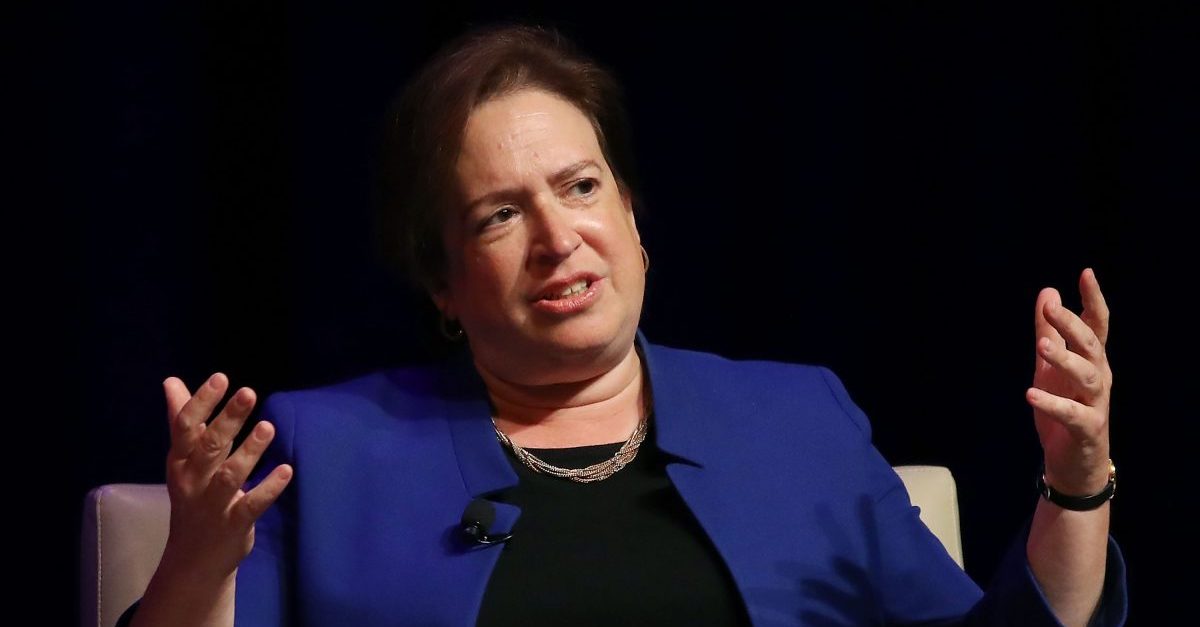
Woah. So yesterday, Supreme Court Justice Elena Kagan made an off-the-cuff remark suggesting that imposing term limits on SCOTUS justices might not be such a bad thing, as they, “might take the high stakes out of the confirmation process.” The 58-year-old justice was quick to add that she’s happy with her own life-tenure gig up on the high bench, and left out whether “high stakes” was inside-SCOTUS code for “insanely undignified lunacy.” Kagan’s comment wasn’t meant to constitute any serious kind of proposal for now, but when our nation’s top legal minds– especially the ones who would personally benefit from the status quo—start saying things, we should probably listen up.
Kagan, by the way, wasn’t the only one who seems to be worn down by the Brett Kavanaugh circus. At a public appearance on Wednesday night, Justice Ruth Bader Ginsburg criticized the confirmation process as having become polarized and embittered. Ginsburg pointed the finger squarely at the legislative branch, saying, “to me, the obvious culprit is Congress.” Boy, what I’d give to hear RBG’s private thoughts on Lindsey Graham’s hissy-fit.
Ginsburg didn’t opine on a specific solution for the mess the confirmation process has become, but legal scholars have been kicking around the idea of term limits for justices for a while. The most common suggestion embraced by such experts is a system of staggered 18-year terms – if another debacle of either the Merrick Garland or the Kavanaugh variety lurks on the horizon, I’m certainly game. Eighteen-year terms have some obvious benefits.
It could be fair, numbers-wise.
If a staggered 18-year term system were implemented, it could be done such that every president would get to nominate two justices per term, no more, no less. With the understanding that the early departure of a justice would result in a temporary seat-filling by a lower court judge until the end of the term, a predictable system would eliminate all the ridiculous gamesmanship we’ve seen lately.
Presidents shouldn’t build campaigns on promises of court-packing, and justices shouldn’t base their retirement decisions on politics. Two apiece seems nice and fair — which probably means that anyone in a position to effect such a change would be vehemently against it.
It’d reduce the drama to a more court-appropriate level.
If the Kavanaugh hearing proved anything (or at least anything other than that our newest justice is a beer-enthusiast who is woefully bereft of judicial temperament), is that’s that Americans can be spun into a frenzy over anything the cable news people says can, “affect us for generations to come.” Confirmation hearings for judges should not be win-at-all-costs events.
They’re important, for sure, but things have gotten a bit out of control.
I’d always thought it was a good thing for Americans to be actively engaged in the functioning of government. But last month’s confirmation hearing made me long for the days when the most popular SCOTUS question was: “Is Judge Judy on the Supreme Court?”
The age thing.
When any appointment is “for life,” the obvious play is to give it the biggest bang for the buck. As a result, we’re seeing presidents nominate judges old enough to have some experience, but young enough to last multiple decades on the Court. This adds up to the misguided choice to exclude potential nominees older than, say, 60. That’s not a good idea.
There are a great many judges who will have reached the pinnacle of their judicial experience between age 60 and 70; excluding them on the basis that their life term isn’t long enough is a sacrifice we shouldn’t be making. Back when the average life expectancy peaked at 60, the difference between an 18-year term and a life term might have been negligible; now, though we may want to seriously reconsider the wisdom of choosing a panel of elders that includes no actual elders.
Eighteen-year terms are, by no means, the only solution to the recent erosion of the Supreme Court’s dignity. Some scholars have suggested age limits or term delays as a potential for relief; a delayed start could diminish any pressure on a new justice to exhibit loyalty to his or her presidential benefactor. Perhaps more importantly, it could eliminate something like the Trump-Kavanaugh-immunity situation, in which a president supports a nominee largely for the effect that nominee would have on cases involving that president personally.
Regardless of the specifics of any particular solution, it’s newsworthy that sitting justices are publicly acknowledging the existence of a problem. At least two of members of the Court have now seen the dark reality created by lifetime appointments. Either that, or after two weeks with Brett Kavanaugh as their colleague, that post-court speaking circuit is sounding better and better.
[Image via Mark Wilson/Getty Images]
This is an opinion piece. The views expressed in this article are those of just the author.